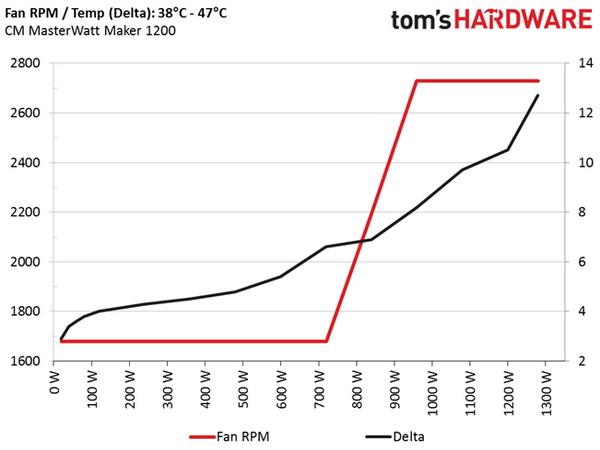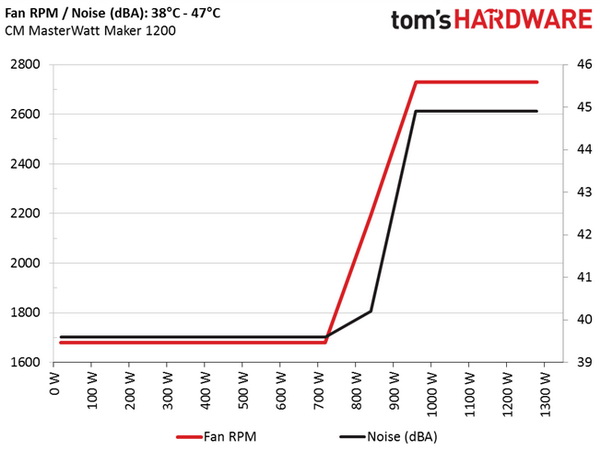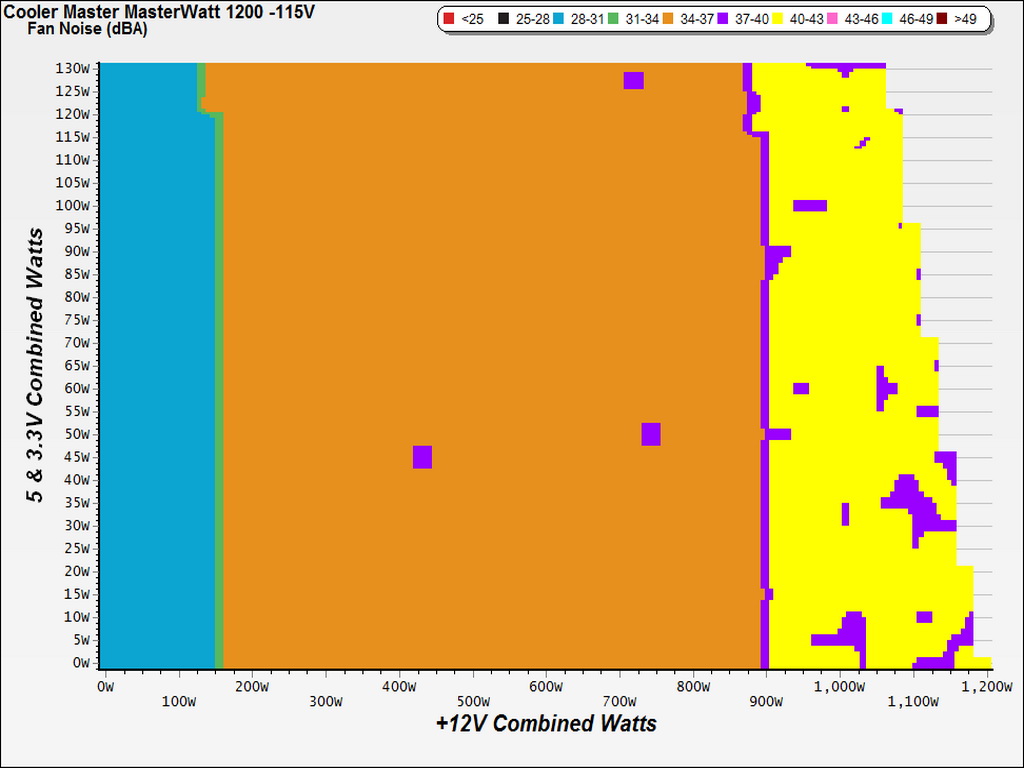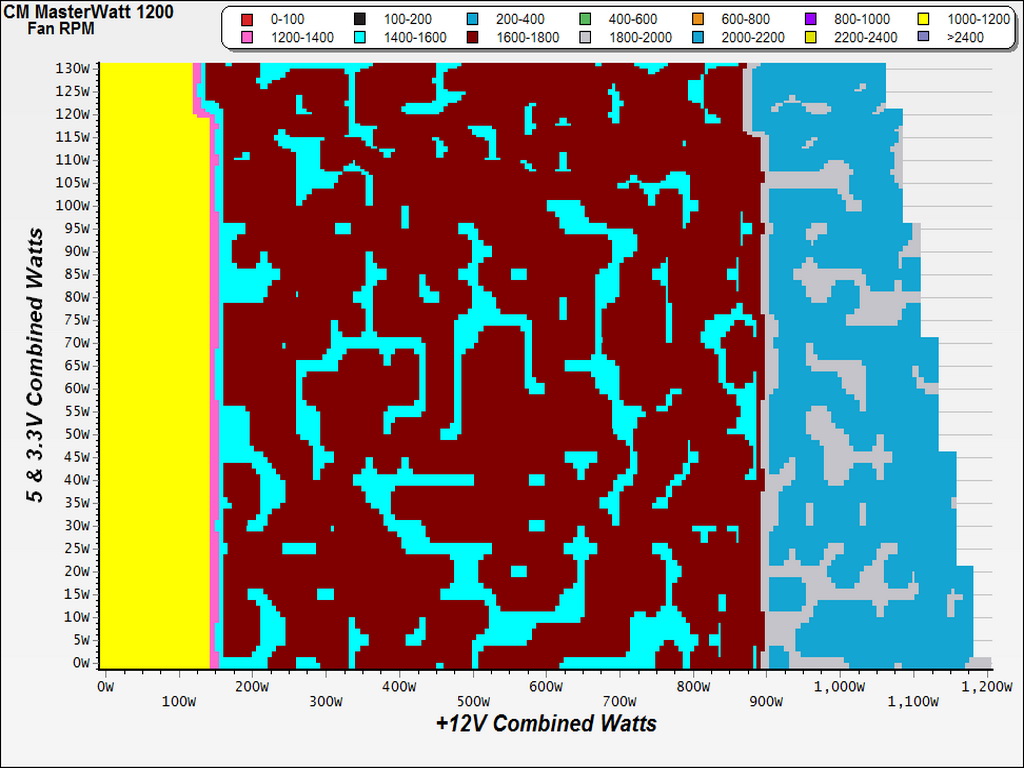Cooler Master MasterWatt Maker 1200 PSU Review
Cooler Master finally released its MasterWatt Maker PSU, which was designed for true enthusiasts. Sporting Titanium-class efficiency, a digital interface, and other exotic features, we didn't expect an affordable price. But $450 looks insane!
Why you can trust Tom's Hardware
Efficiency, Temperature, And Noise
Efficiency
Our efficiency testing procedure is detailed here.
Using the results from the previous page, we plotted a chart showing the MasterWatt 1200's efficiency at low loads, and loads from 10 to 110 percent of the PSU's maximum-rated capacity.
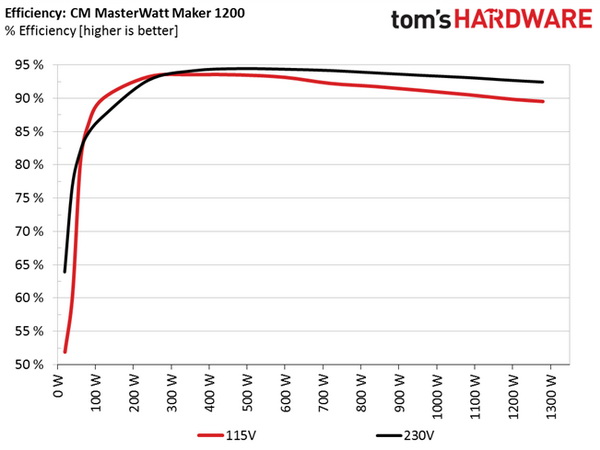


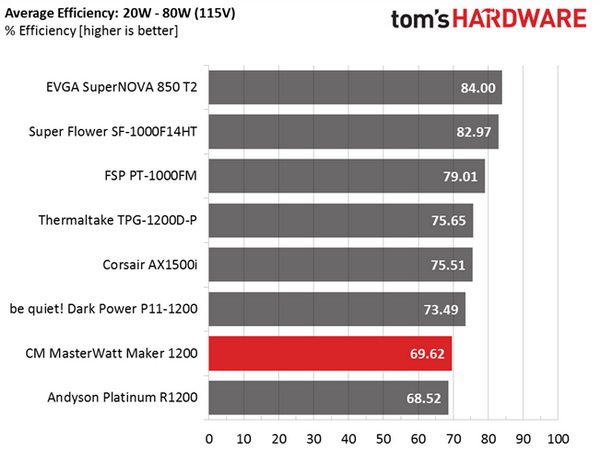
Efficiency under normal loads is very high, matching the AX1500i's performance. However, under light loads, the MasterWatt 1200 posts one of the lowest efficiency readings we have ever measured from a high-end PSU. What a shame. Apparently, Enhance tuned this unit with the 10%-100% load region in mind, and with anything lower than 10% of its maximum-rated capacity, efficiency takes a large hit.
Efficiency At Low Loads
In the following tests, we measure the MasterWatt 1200's efficiency at loads significantly lower than 10 percent of its maximum capacity (the lowest load the 80 PLUS standard measures). The loads we dialed were 20, 40, 60 and 80W. This is important for representing when a PC is idle, with power-saving features turned on.
| Test # | 12V | 5V | 3.3V | 5VSB | DC/AC (Watts) | Efficiency | Fan Speed | Fan Noise | PF/AC Volts |
|---|---|---|---|---|---|---|---|---|---|
| 1 | 1.203A | 0.481A | 0.475A | 0.194A | 19.57 | 51.87% | 1680 RPM | 39.6 dB(A) | 0.826 |
| 12.077V | 5.119V | 3.350V | 5.105V | 37.73 | 115.1V | ||||
| 2 | 2.438A | 0.976A | 0.984A | 0.390A | 39.71 | 60.62% | 1680 RPM | 39.6 dB(A) | 0.908 |
| 12.083V | 5.102V | 3.348V | 5.079V | 65.51 | 115.1V | ||||
| 3 | 3.672A | 1.466A | 1.492A | 5.061A | 59.82 | 80.17% | 1680 RPM | 39.6 dB(A) | 0.918 |
| 12.086V | 5.093V | 3.346V | 5.061V | 74.62 | 115.1V | ||||
| 4 | 4.897A | 1.964A | 1.970A | 0.790A | 79.72 | 85.81% | 1680 RPM | 39.6 dB(A) | 0.928 |
| 12.081V | 5.084V | 3.344V | 5.044V | 92.90 | 115.1V |
The 20W and 40W efficiency results are an insult for any PSU boasting the 80 PLUS Titanium certification, even at this capacity level. With 60W and above, Cooler Master surpasses the 80% mark.
Cooler Master Connect Screenshots
Below you will find screenshots of the Connect software, which we took during the light-load test sessions.
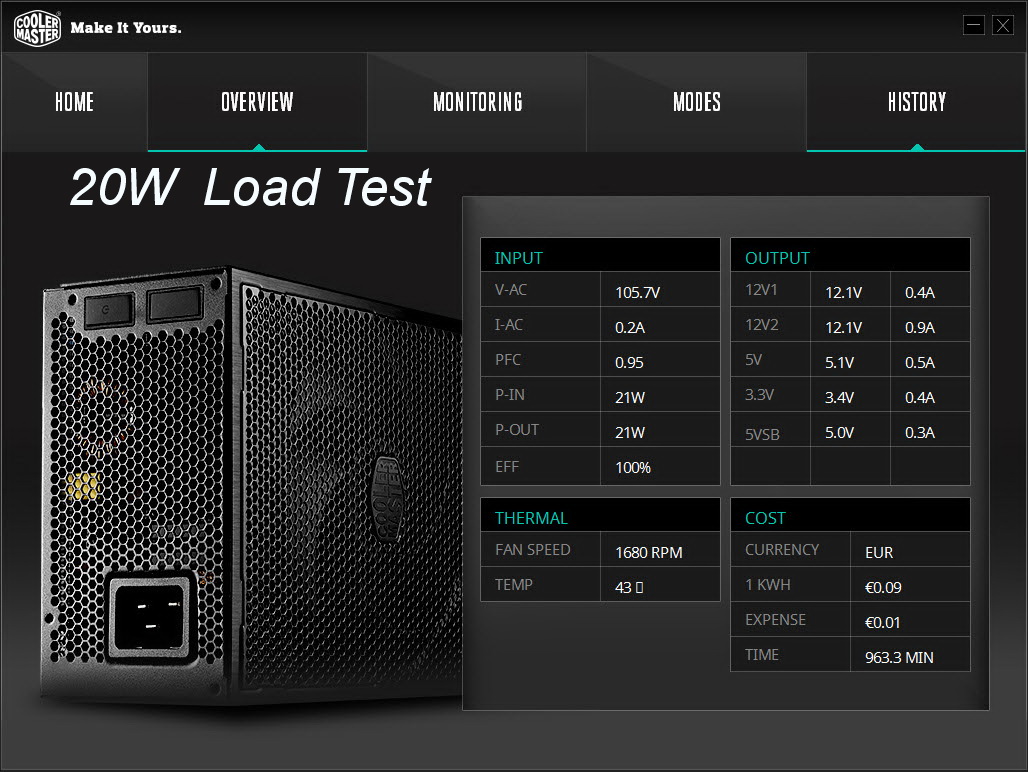
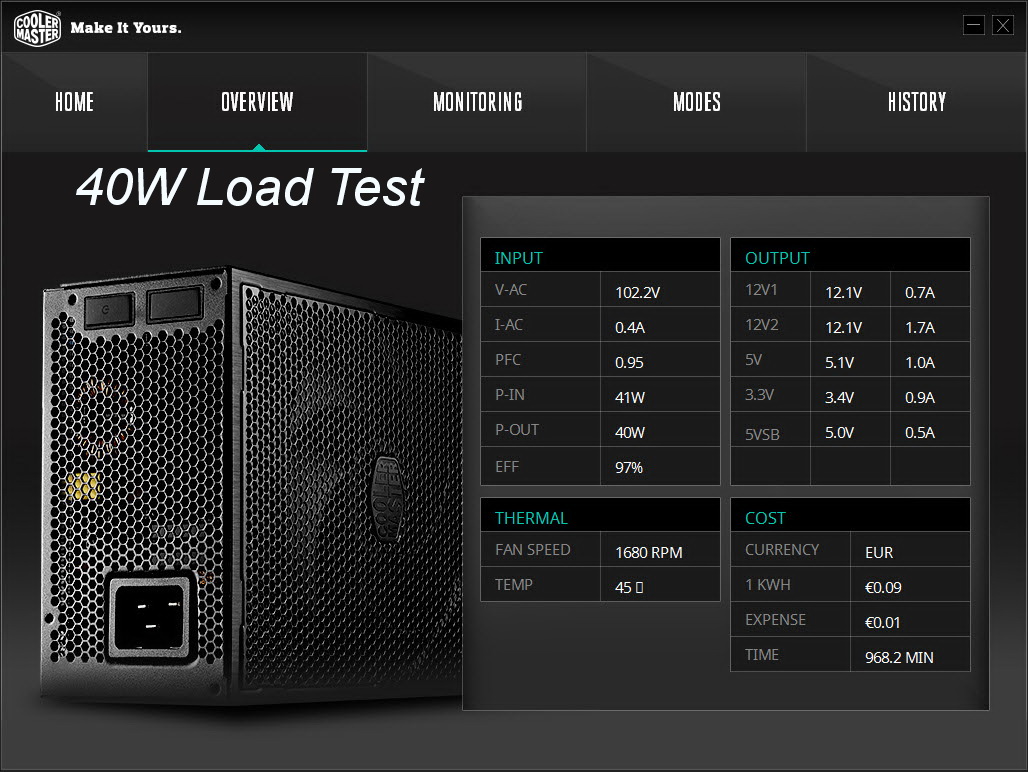


The software's efficiency readings are nowhere near reality.
Get Tom's Hardware's best news and in-depth reviews, straight to your inbox.
5VSB Efficiency
The ATX specification states that 5VSB standby supply efficiency should be as high as possible, recommending 50 percent or higher efficiency with 100mA of load, 60 percent or higher with 250mA of load and 70 percent or higher with 1A or more of load.
We take four measurements: one each at 100, 250 and 1000mA, and one with the full load the 5VSB rail can handle.
| Test # | 5VSB | DC/AC (Watts) | Efficiency | PF/AC Volts |
|---|---|---|---|---|
| 1 | 0.101A | 0.50 | 52.08% | 0.046 |
| 4.995V | 0.96 | 115.1V | ||
| 2 | 0.251A | 1.25 | 66.85% | 0.088 |
| 4.985V | 1.87 | 115.1V | ||
| 3 | 1.002A | 4.95 | 77.71% | 0.243 |
| 4.939V | 6.37 | 257.6V | ||
| 4 | 3.502A | 16.76 | 77.74% | 0.417 |
| 4.787V | 21.56 | 115.1V |

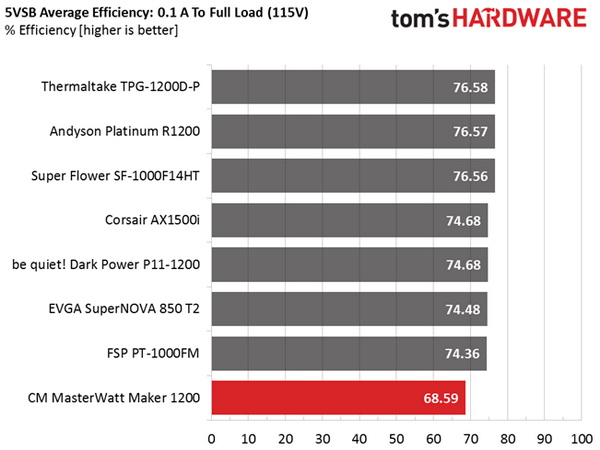
We measure very low 5VSB efficiency. Enhance should do a better job here.
Power Consumption In Idle And Standby
In the table below, you'll find the power consumption and voltage values of all rails (except -12V) when the PSU is idle (powered on, but without any load on its rails), and the power consumption when the PSU is in standby mode (without any load, at 5VSB).
| Mode | 12V | 5V | 3.3V | 5VSB | Watts | PF/AC Volts |
|---|---|---|---|---|---|---|
| Idle | 12.095V | 5.156V | 3.358V | 5.155V | 9.02 | 0.388 |
| 115.1V | ||||||
| Standby | 0.33 | 0.016 | ||||
| 115.1V |
Phantom power is higher than usual in this discipline. Still, it is lower than 0.5W.
Fan RPM, Delta Temperature And Output Noise
Our mixed noise testing is described in detail here.
The first chart below illustrates the cooling fan's speed (in RPM), and the delta between input and output temperature. The results were obtained at 38 °C (100.4 °F) to 47 °C (116.6 °F) ambient temperature.
The next chart shows the cooling fan's speed (again, in RPM) and output noise. We measured acoustics from one meter away, inside a small, custom-made anechoic chamber with internals completely covered in sound-proofing material (be quiet! Noise Absorber kit). Background noise inside the chamber was below 18 dB(A) during testing, and the results were obtained with the PSU operating at 38 °C (100.4 °F) to 47 °C (116.6 °F) ambient temperature.
The following graphs illustrate the fan's output noise and speed over the PSU's operating range. The same conditions of the above graph apply to our measurements, though the ambient temperature was between at 28 °C (82.4 °F) to 30 °C (86 °F).
Under normal operating temperatures and with the default mode selected, the PSU is quiet given its high capacity. Passive operation wasn't active during our cross-load tests because temperatures inside the PSU need to be lower than 20 °C. If you select Silent mode, the PSU operates passively during light loads, resulting in lower output noise.
The graph above looks like a messy canvas due to the small fan speed variations that our equipment recorded.
Current page: Efficiency, Temperature, And Noise
Prev Page Load Regulation, Hold-Up Time And Inrush Current And Protections Next Page Protection Features, Evaluated
Aris Mpitziopoulos is a contributing editor at Tom's Hardware, covering PSUs.
-
Onus Shades of the GX line; Coolermaster swings for the fences, but a competitor (pick one) in the outfield snags it and throws this one out trying to stretch a single to second base.Reply -
MasterMace CM doesn't get to put a $450 price tag on something that isn't in the same park. That voltage regulation is disappointing.Reply -
turkey3_scratch A lot of hype and little delivery for that price tag of course. Lower that price down to $200 and then we may be talking. The efficiency under low loads was quite poor. I'd like to bash the 5VSB regulation, though that's going to be unimportant and unrealistic with the majority of consumers, having load changes on that rail. Though if you are charging multiple devices I'd rather have it at 5V than 4.75V.Reply
At least the transient response performance was really good. The PWR_OK signal, eh. Aris, do you think that transient filter is really enough? I have a feeling it would fail EMI testing, only 4 y caps, 4 x caps, and 2 cm chokes on the unit.
Overall, Cooler Master paired with the wrong OEM. -
Aris_Mp the transient filtering stage looks complete since it has more than the required X caps, however you can never know unless you actually test it. I have the equipment and knowledge but I lack the time to do it :)Reply -
turkey3_scratch What are the exact requirements? I know what the ATX spec says but you have units like the FSP Hydro G 750 that failed by a good margin with 4 y caps, 2 x caps, and 2 cm chokes. So when talking about a 1200W unit with 4 y caps, 4 x caps, and 2 cm chokes, those 2 extra x caps are enough to do the trick?Reply -
Nuckles_56 The performance per dollar chart was great, it showed how badly overpriced this unit is and that there is a lot which could be improved on for the money spent on the unitReply -
Andi lim It's seem like the solid polymer caps on front side modular PCB's not from Nichicon, I think it belongs to Unicon taiwan ( UPT series ).Reply -
jimmysmitty Reply18352433 said:CM doesn't get to put a $450 price tag on something that isn't in the same park. That voltage regulation is disappointing.
Sadly it is more than the AX1500i, lower efficiency and specs overall and a lower warranty (7 year vs 10 year).
If someone is going to spend that much on a PSU It would be better to go for the Corsair.
